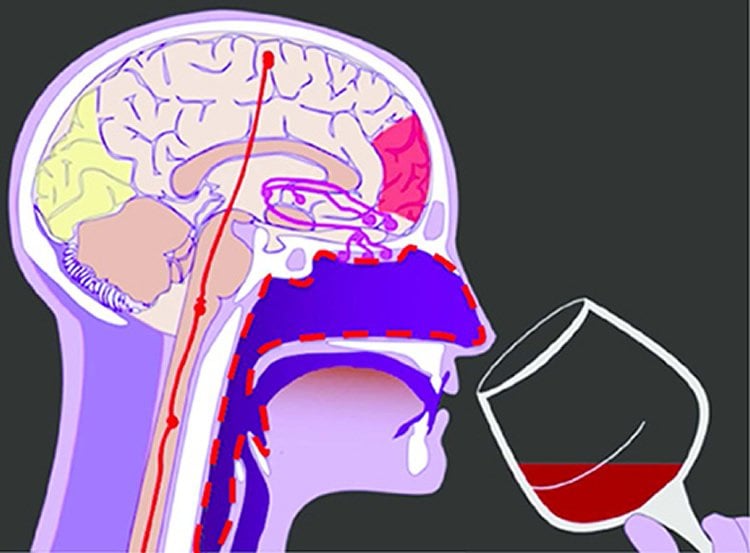The sweetness of a peppermint candy can be experienced with the nose pinched shut, but flavor is detectable only when the pinch is released and volatiles in the candy are exhaled back into the nose where smell receptors exist.
Exactly how this happens was not known, but now a multi-disciplinary team at Yale University has built a 3-D model of the mechanisms that help bring flavor into our lives.
“The study appears to confirm that humans are especially adapted to enhance this form of smell, and reinforces the idea of the central role flavor plays in human diets,” said Gordon Shepherd, professor of neuroscience and senior author of the paper appearing the week of Nov. 9 in the journal Proceedings of the National Academy of Science.
The collaboration involved flow dynamics researchers from engineering and imaging experts at the medical school, who created a scan of the throat, which in turn was used to create a 3D printout at the Yale Center for Engineering Innovation and Design.
Researchers said they were surprised to find that the dynamic flow patterns suggested that the oropharynx at the back of the mouth was shaped to allow particles to collect in a virtual cavity where they could be efficiently picked up by the exhaling flow, a process known as retronasal smell. In contrast, the flow lines during inhalation passed right by this cavity, thus minimizing the transport of particles into the lungs. This difference occurred even at the relatively low flow rates during normal breathing when we are eating.

The researchers speculated that these mechanisms allow us to immediately sense by retronasal smell — as well as touch and taste —whether to accept a substance in our mouth. In addition, inhalation of the volatiles into the lungs is minimized in case those volatiles provide a warning not to accept the food.
Other Yale affiliated authors are Rui Ni, Mark H. Michalski, Elliott Brown, Ngoc Doan, Joseph Zinter, and Nicholas T. Ouellette.
Funding: The research was funded by grant R01 DC00997701 from the National Institute on Deafness and Other Communicative Disorders of the National Institutes of Health and the National Science Foundation under grant DMS-1211952.
Source: Bill Hathaway – Yale
Image Credit: The image is adapted from the Yale press release
Original Research: Abstract for “Optimal directional volatile transport in retronasal olfaction” by Rui Ni, Mark H. Michalski, Elliott Brown, Ngoc Doan, Joseph Zinter, Nicholas T. Ouellette, and Gordon M. Shepherd in PNAS. Published online November 9 2015 doi:10.1073/pnas.1511495112
Abstract
Optimal directional volatile transport in retronasal olfaction
The ability of humans to distinguish the delicate differences in food flavors depends mostly on retronasal smell, in which food volatiles entrained into the airway at the back of the oral cavity are transported by exhaled air through the nasal cavity to stimulate the olfactory receptor neurons. Little is known whether food volatiles are preferentially carried by retronasal flow toward the nasal cavity rather than by orthonasal flow into the lung. To study the differences between retronasal and orthonasal flow, we obtained computed tomography (CT) images of the orthonasal airway from a healthy human subject, printed an experimental model using a 3D printer, and analyzed the flow field inside the airway. The results show that, during inhalation, the anatomical structure of the oropharynx creates an air curtain outside a virtual cavity connecting the oropharynx and the back of the mouth, which prevents food volatiles from being transported into the main stream toward the lung. In contrast, during exhalation, the flow preferentially sweeps through this virtual cavity and effectively enhances the entrainment of food volatiles into the main retronasal flow. This asymmetrical transport efficiency is also found to have a nonmonotonic Reynolds number dependence: The asymmetry peaks at a range of an intermediate Reynolds number close to 800, because the air curtain effect during inhalation becomes strongest in this range. This study provides the first experimental evidence, to our knowledge, for adaptations of the geometry of the human oropharynx for efficient transport of food volatiles toward the olfactory receptors in the nasal cavity.
“Optimal directional volatile transport in retronasal olfaction” by Rui Ni, Mark H. Michalski, Elliott Brown, Ngoc Doan, Joseph Zinter, Nicholas T. Ouellette, and Gordon M. Shepherd in PNAS. Published online November 9 2015 doi:10.1073/pnas.1511495112






